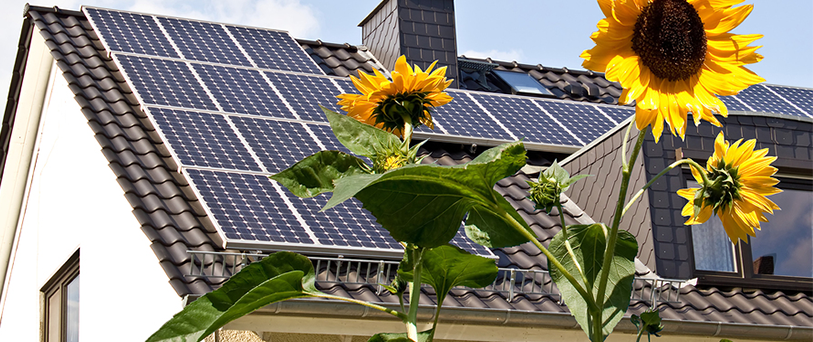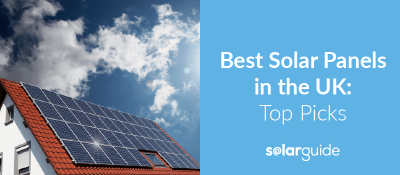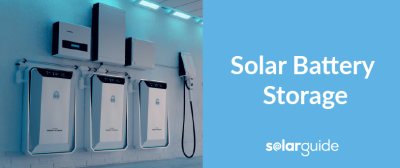How to Choose Solar Panels for Your Home

If the idea of lower energy bills all year round appeals to you then solar panels are the answer.
Before getting to enjoy the many benefits of solar panels, you'll need to find the right solar system to match the electricity demand of your home. With a number of different solar options available, this guide will show you how to choose solar panels for your home.
Get Free Solar Panel Quotes: Get quotes and compare prices.
Why Install Solar Panels?
If you're interested in installing solar panels, it's likely that you already know the benefits that solar panels can bring your home. Nonetheless, here are a few reasons why solar panels are well worth considering:
- Reduced energy bills
- Lower the carbon footprint of your home
- Charge and electric car (EV) for free
- Lengthy lifetime
- No running costs whatsoever
- Need very little maintenance
- Receive payments through the Smart Export Guarantee (SEG)
How to Choose Solar Panels for Your Home
When it comes to choosing solar panels for your home, there are several things that you'll need to consider:
- Solar PV or solar thermal panels
- Type of solar cells
- Power output
- Number of panels
- Efficiency
- Bifacial panels
- Mounting
- Cost
Solar PV or solar thermal?
Solar PV panels generate electricity to power appliances around the home while solar thermal panels are a solar water heating system. A solar thermal system can only be installed into a property where the hot water is stored in a hot water cylinder.
Type of solar cells
Solar panels are commonly made from silicon, with 2 different types of solar panels to choose from: monocrystalline (mono) and polycrystalline (poly). Both work in the same way to generate free renewable energy using the sunlight but there are some key differences to be aware of.
Monocrystalline panels have a black appearance and are generally considered to be the most stylish of the two choices. They're able to achieve higher levels of efficiency and even though they have a higher price tag, are the most popular option in the UK.
Polycrystalline panels have a blue colour and while they have a lower price attached to them they aren't able to achieve such high levels of efficiency.
| Type of Solar Panel | Monocrystalline | Polycrystalline |
| Efficiency | Higher efficiency (15-20%) | Lower efficiency (13-16%) |
| Cost | More expensive | Cheaper option |
| Aesthetics | Black | Blue |
Power output
The power output of solar panels shows how much energy they're capable of generating and is measured in watts (W). Most solar panels have a power output of between 250 watts and 360 watts but 400 watt models are available too.
Finding the right power output for your home comes down to how much electricity is used in you use. Using a recent electricity bill, simply note how much electricity has been used – measured in kilowatt hours (kWh) – over a certain time period.
| House Type | Average Annual Electricity Usage (kWh) | Average Daily Electricity Usage (kWh) |
| Mid Terrace | 2,779 | 7.6 |
| Flat | 2,829 | 7.7 |
| End Terrace | 3,442 | 9.4 |
| Semi Detached | 3,847 | 10.5 |
| Bungalow | 3,866 | 10.6 |
| Detached | 4,153 | 11.3 |
In the UK, a typical household uses around 8.5-10 kWh each day, this total varies depending on house type and the number of people living in it. So, a solar panel with a power output of 250 watts in 4 hours of direct sunlight would be generating 1,125 watts per hour (Wh), that's 1.1kWh each day. To reach the average daily electricity usage, this would mean installing more than one panel, known as a solar PV system or solar array.
Get Free Solar Panel Quotes: Get quotes and compare prices.
Number of panels
Solar arrays in the UK are normally between 1kW and 4kW which can incorporate anywhere between 2-16 individual panels.
The number of panels needed will depend on the amount of power needed from the solar panels and the available space on the roof. You can work out the number of solar panels you might need using:
- Average daily electricity usage
- Solar panel power output
- Sunlight hours
During a year, the average UK home will receive around 4.5 hours of sunlight each day – a figure that will increase during the summer and shorten through the winter.
Now we need to calculate how much electricity a solar panel is capable of generating on any given day. To do this, we need to multiply daytime sunshine hours by the power output of the solar panel.
For this example we'll be working out how many solar panels you need for your home using solar panels with a 300 watt power output. So, we first need to calculate 4.5 x 300 (sunlight hours x solar panel power output) which comes to 1,350 watt-hours (1.35 kWh).
Dividing this figure by the average average daily electricity usage will then reveal how many solar panels your home needs (7.6/1.35).
| Average Daily Electricity Usage (kWh) | Number of 240 watt solar panels | Number of 300 watt solar panels | Number of 400 watt solar panels | |
| Mid Terrace | 7.6 | 7 | 6 | 4 |
| Flat | 7.7 | 7 | 6 | 4 |
| End Terrace | 9.4 | 9 | 7 | 5 |
| Semi Detached | 10.5 | 10 | 8 | 6 |
| Bungalow | 10.6 | 10 | 8 | 6 |
| Detached | 11.3 | 10 | 8 | 6 |
These figures are based on the solar panels being able to generate 100% of your home's daytime electricity usage. If you only want the solar panels to make up part of your electricity generation, then you won't need as many solar panels.
For a more accurate calculation, find your average daily electricity usage on a recent energy bill.
Efficiency
The efficiency rating of a solar panel shows you how well it converts the sun's energy into electricity. Efficiency is displayed as a percentage – the higher the percentage, the more efficient the panels. You'll find that most solar panels have efficiencies of between 10-20% but 25% models are also available.
Solar panel efficiency does drop over time – around 0.5% each year – and as they have such a lengthy lifetime (20-25 years), manufacturers offer a power warranty that guarantees a certain level of efficiency after a set amount of time. Comparing power warranties will give you an idea of how well different panels will be performing further down the line.
Solar panel efficiency can be affected by a number of factors, such as placement, shading, angle of the roof, how often they're cleaned and the outdoor temperature (efficiency can drop in really high temperatures). A solar installer will be able to recommend the optimal position for your solar panel installation.
Warranty
Solar panels come with 2 warranties, a product warranty and a power warranty. As we mentioned earlier, the power warranty is an indication of how efficiently the solar panels will be performing when they've been installed for a number of years.
The product warranty is the number of years that you'll be covered by the manufacturer in the event of an issue with the solar panels.
Mounting
When it comes to mounting, the solar panels should be installed at an angle, facing south and away from any large trees that will put them into shade.
To help get the solar panels into the most efficient position, there are several mounting options available.
Cost
The solar panel costs is bound to be the deciding factor for many homeowners and while it can be tempting to go down the cheapest route, you're unlikely to see as much of a return on your investment.
All models of solar panel will have their own prices with the total being dependent on the demand your home has for electricity.
Fortunately, on the whole, solar panels are at their cheapest point for a number of years and typically costs £6,000 – £7,000.
Consulting a professional solar panel installer will give you the best idea when it comes to finding the right solar panels for your home.
Get Free Solar Panel Quotes: Get quotes and compare prices.
Solar Panel Savings
Generating your own free renewable energy will reduce the reliance you have on your supplier and you'll see your energy bills drop as a result.
While solar panels are most effective during the summer, they work all year round, even on cloudy days – good news for homeowners here in the UK.
Many homeowners see a reduction of 40-50% on their energy bills thanks to solar panels which can mean a solar payback time of 11-12 years depending on where you live and how much the solar panels cost.
Adding a solar battery to your solar PV system and you could see even greater savings.
Solar Batteries
No matter the size of the solar PV system they're bound to be generating more energy than can be used around the home. This excess energy is automatically sent to the National Grid, meaning that you're missing out on an awful lot of energy being generated by your solar panels.
Adding a solar battery to your solar PV system will allow you to store unused energy during the day to use when your solar panels aren't generating any energy once the sun's gone down.
Additionally, in the UK, energy usage for the average household peaks between 6-7pm, a time that during a large part of the year isn't bathed in sunlight. Storing energy during the day will mean that there's energy to use in the evening when the panels aren't generating energy.
Some solar batteries can act as a backup power supply in the event of a power cut – in some cases this is an optional extra. During a powercut, solar panels are unable to work but installing a solar battery with a power cut backup feature will guarantee that you'll still have power. Solar batteries that include this feature include:
- Tesla Powerwall 2.0
- SonnenBatterie Eco
- Samsung SDO
- Solax Battery
- Puredrive ESS
Get Free Solar Panel Quotes: Get quotes and compare prices.
Bifacial Panels
Bifacial solar panels have solar panels on either side, rather than only on the side facing outwards. This means that when installed onto a reflective surface, energy can be generated with both sides of the solar panels to maximise generation and deliver up to 30% more energy than conventional solar panels.
When it comes to finding the best bifacial solar panels, there are several models to choose from in the UK. In terms of efficiency and warranty, the NeON 2 bifacial solar panels manufactured by LG currently lead the way.
| Manufacturer | Model | Type of Panel | Standard Maximum Efficiency | Product Warranty |
| Canadian Solar | BiKu CS3U-375MB-FG | Mono | 18.04% | 10 years |
| LG | NeON 2 Bifacial 395W | Mono | 18.7% | 25 years |
| SolarWorld | Sunmodule Bisun protect 290 clear | Mono | 17.3% | 20 years |
| Yingli Solar | PANDA Bifacial 144HCL 360W | Mono | 17.8% | 10 years |
What happened to the Feed-in Tariff?
The Feed-in Tariff (FiT) was a government scheme designed as an incentive for homeowners to install solar panels. Eligible solar panel installations entitled homeowners to quarterly payments for upwards of 20 years but the scheme came to an end in March 2019.
At first there was no indication that the FiT would be replaced but the government has since confirmed that as of January 2020, the Smart Export Guarantee (SEG) will be introduced.
Through the Smart Export Guarantee, domestic solar panel owners will receive payment from their energy supplier for each unit of generated electricity sent to the National Grid.
Energy suppliers with over 150,000 customers have a legal obligation to pay eligible customers while smaller suppliers will have the choice. The rate paid to homeowners for the electricity sent to the National Grid will be at the discretion of the individual energy suppliers.
Free Solar Panel Installation Quotes
Comparing multiple quotes will really help when it comes to finding the most competitive deal on the solar panel installation.
Take a few moments to complete our simple online form and you can get free quotes from up to 4 solar panel installers based in your local area. Comparing more than 1 quote will give you a much greater chance of finding the most competitive price for a solar panel installation where you live.
Get Free Solar Panel Quotes: Get quotes and compare prices.
Find local, MSC certified Solar Installers
Start your quote
Find local, MSC certified Solar Installers














